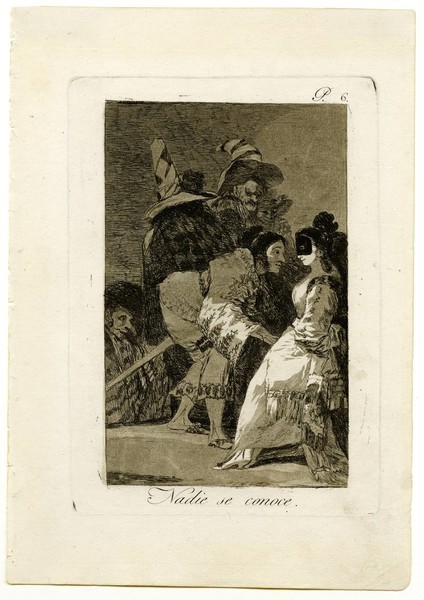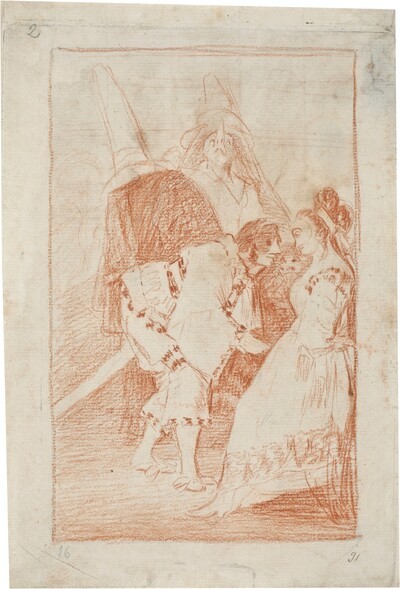- Cronología
- Ca. 1797 - 1799
- Dimensiones
- 219 x 153 mm
- Técnica y soporte
- Etching and burnished aquatint
- Reconocimiento de la autoría de Goya
- Undisputed work
- Ficha: realización/revisión
- 17 Nov 2010 / 29 May 2024
- Inventario
- 225
Nadie se conoce. (at the bottom).
P.6 (upper right corner)
See Francisco de Goya y Lucientes, Painter.
There are some state proofs that show an extraordinary use of aquatint. In one of them, the burnishing on the carnival hat, the sword of the figure in the centre and the ground can be clearly seen, as it is less heavily inked than the first printings of the editions.
A preparatory drawing in sanguine is kept in the Prado Museum.
On the right-hand side of the engraving we see a woman in profile wearing a mask over her face; she is smiling with a gesture of pleasure. In front of her, slightly reclining and standing at the level of her face, a figure also wearing a mask looks at her attentively. Behind her are other figures dressed in peculiar costumes; some of them are wearing large hats, and in the case of the one at the lower left and the one in the centre, their faces also appear to be covered by masks; his face is wearing a mask and he is smiling in a pleasant manner. In front of her, slightly reclining and standing at the level of her face, a figure also wearing a mask looks at her attentively. Behind her are other figures dressed in peculiar ways; some of them are wearing large hats, and in the case of the one at the lower left and the one in the centre, their faces also appear to be covered by masks.
It is a dark environment in which Goya uses aquatint to capture the young woman's clothing, the lightest part of the engraving. Much of the background is executed with very continuous, close etching strokes.
In Ayala's manuscript it is said of this work that "the world is a mask; the face, the costume and the voice are all feigned. An effeminate General presents madame with a gift in front of other cuckolds". The Prado Museum manuscript states that "the world is a mask, the face, the costume and the voice are all faked; everyone wants to pretend to be something they are not, everyone is deceived and no one knows each other". Finally, the manuscript in the National Library notes that "an effeminate general or disguised as a woman at a party is asking a good girl for it; he lets himself be known by the embroidery on his sleeve; the husbands are behind, and instead of hats, they appear with tremendous horns like a unicorn. If he covers himself well, he comes out straight; if he doesn't, he comes out crooked".
The most powerful aspect of this image is the ambiguity that does not allow us to discern whether the figure in the foreground, who is gazing at the woman, is a man or not. This vagueness is accentuated by the use of the masks which, contrary to what one might think, do not conceal the identity of the wearer, but reveal his true nature. This is precisely what Goya does in the Caprice no. 2, Yes they pronounce and the hand they lengthen, in which the woman wears a mask on the back of her head that describes some aspects of her character.
Carnival and masked balls are present in many of Goya's works; it is a festival that had an important tradition in Madrid at the end of the 18th century. It was a common practice among some of the most important aristocratic figures, such as the Duchess of Alba, who held costume parties famous for their sumptuousness. The importance of this type of festivities was such that even the masks were made by some of the most famous artists of the time.
This print is strongly influenced by Venetian painting, especially the Capricci by Giovanni Battista Tiepolo (Venice, 1696-Madrid, 1770) in which some of the characters seem to have been taken from the Commedia dell'Arte, as is also the case in the Goyaesque engraving.
The plate is fairly well preserved, although the etching is weakened ( Nacional Chalcography, no. 177).
-
Goya. Gemälde Zeichnungen. Graphik. TapisserienKunsthalle BaselBasle1953from January 23th to April 12th 1953cat. 198
-
El arte de GoyaMuseo de Arte Occidental de TokioTokyo1971from 16th 1971 to January 23th 1972. Exhibited also at the Kyoto Municipal Museum of Art, January 29th to March 15th 1972.cat. 556
-
Goya. Das Zeitalter der Revolucionen. Kunst um 1800 (1980 – 1981)Hamburger KunsthalleHamburg1980cat. 43
-
Goya. La década de Los CaprichosMadrid1992organized by Real Academia de Bellas Artes de San Fernando sponsored by Fundación Central Hispano, Madrid, consultant editor Nigel Glendinnig. From October 26th 1992 to January 10th 1993cat. 10
-
Francisco de GoyaMuseo d'Arte ModernaLugano1996exhibition celebrated from September 22nd to November 17th.cat. 6, p.33
-
Ydioma universal: Goya en la Biblioteca NacionalBiblioteca NacionalMadrid1996from September 19th to December 15th 1996cat. 129
-
Francisco Goya. Sein leben im spiegel der graphik. Fuendetodos 1746-1828 Bordeaux. 1746-1996Galerie KornfeldBern1996from November 21st 1996 to January 1997cat. 12
-
Goya artista de su tiempo y Goya artista únicoThe National Museum of Western ArtTokyo1999from December 1st to July 3th 1999cat. 6, p.18
-
Francisco Goya. Capricci, follie e disastri della guerraSan Donato Milanese2000Opere grafiche della Fondazione Antonio Mazzottacat. 6, p.147
-
Goya e la tradizione italianaFondazione Magnani RoccaMamiano di Traversetolo (Parma)2006consultant editors Fred Licht and Simona Tosini Pizzetti. From September 9th to December 3th 2006p.23
-
Goya. Opera graficaPinacoteca del Castello di San GiorgioLegnano2006exhibition celebrated from December 16th 2006 to April 1st 2007
-
Goya et la modernitéPinacothèque de ParisParís2013from October 11st 2013 to March 16th 2014cat. 131
-
Madrid2017
-
Hamburg2019cat. 35
-
2022
-
Goya engravings and lithographs, vol. I y II.OxfordBruno Cassirer1964cat. 41, p.76
-
Vie et ouvre de Francisco de GoyaParísOffice du livre1970p.176, cat. 461
-
El mundo de Goya en sus dibujosMadridUrbión1979pp. 18-19
-
La década de los Caprichos. Retratos 1792-1804MadridReal Academia de Bellas Artes de San Fernando1992p.156, cat. 129
-
Goya. El capricho y la invención. Cuadros de gabinete, bocetos y miniaturasMadridMuseo del Prado1993p.46, fig. 22
-
Catálogo de las estampas de Goya en la Biblioteca NacionalMadridMinisterio de Educación y Cultura, Biblioteca Nacional1996p.77, cat. 94
-
El libro de los caprichos: dos siglos de interpretaciones (1799-1999). Catálogo de los dibujos, pruebas de estado, láminas de cobre y estampas de la primera ediciónMadridMuseo Nacional del Prado1999pp.80-83
-
ParísPinacoteca de París2013p. 192
-
Goya. In the Norton Simon MuseumPasadenaNorton Simon Museum2016pp. 42-75
-
ZaragozaGobierno de Aragón y Fundación Bancaria Ibercaja2017p. 267
-
HamburgHirmer2019p. 245
-
Museo de Bellas Artes de Badajoz y Diputación de Badajoz2022p. 30

